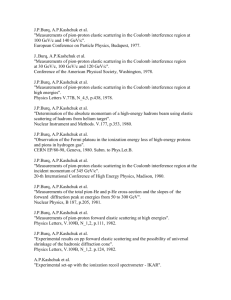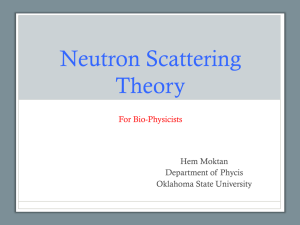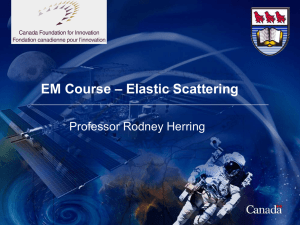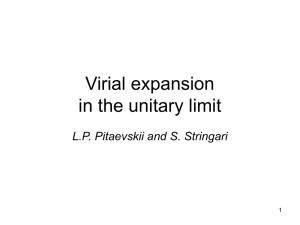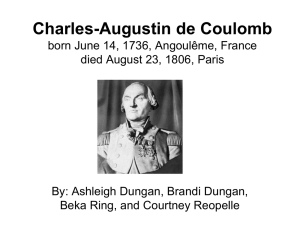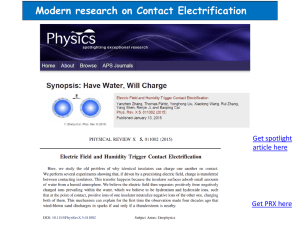elastic - NUCLEAR REACTIONS VIDEO Project
advertisement
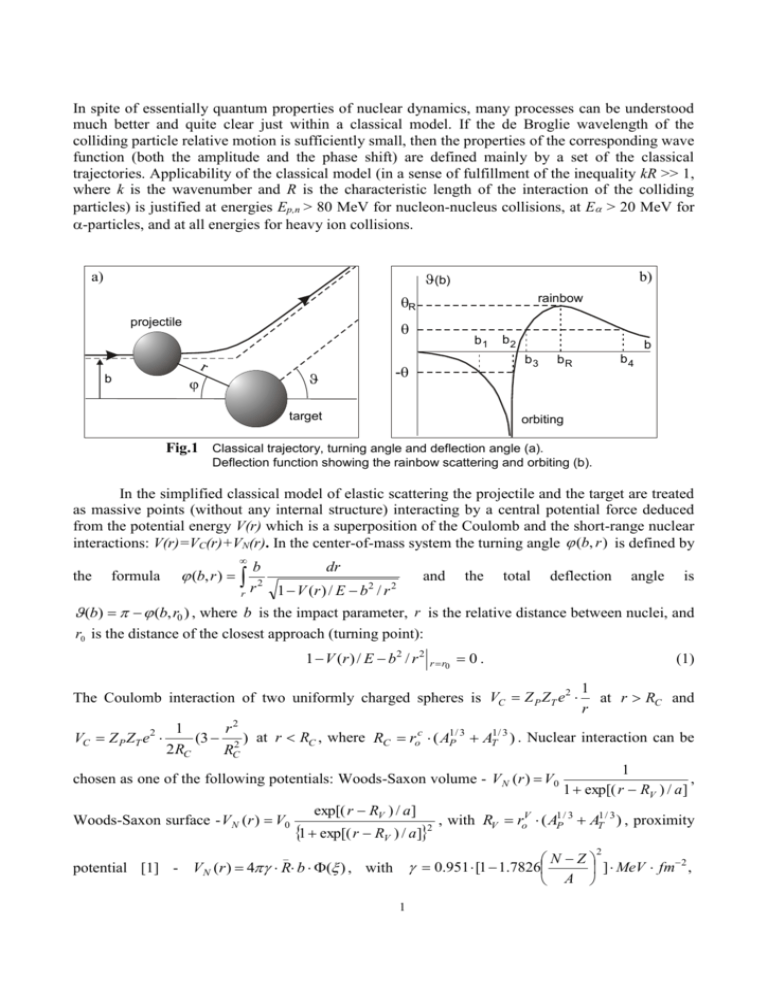
In spite of essentially quantum properties of nuclear dynamics, many processes can be understood
much better and quite clear just within a classical model. If the de Broglie wavelength of the
colliding particle relative motion is sufficiently small, then the properties of the corresponding wave
function (both the amplitude and the phase shift) are defined mainly by a set of the classical
trajectories. Applicability of the classical model (in a sense of fulfillment of the inequality kR >> 1,
where k is the wavenumber and R is the characteristic length of the interaction of the colliding
particles) is justified at energies Ep,n > 80 MeV for nucleon-nucleus collisions, at E> 20 MeV for
-particles, and at all energies for heavy ion collisions.
(b)
a)
b)
R
projectile
r
b
rainbow
b1
b2
b
b3
-
target
b4
bR
orbiting
.
Fig.1 Classical trajectory, turning angle and deflection angle (a).
Deflection function showing the rainbow scattering and orbiting (b).
In the simplified classical model of elastic scattering the projectile and the target are treated
as massive points (without any internal structure) interacting by a central potential force deduced
from the potential energy V(r) which is a superposition of the Coulomb and the short-range nuclear
interactions: V(r)=VC(r)+VN(r). In the center-of-mass system the turning angle (b, r ) is defined by
the
formula
(b, r )
r
b
dr
2
r 1 V (r ) / E b 2 / r 2
and
the
total
deflection
angle
is
(b) (b, r0 ) , where b is the impact parameter, r is the relative distance between nuclei, and
r0 is the distance of the closest approach (turning point):
1 V (r ) / E b 2 / r 2
r r0
0.
The Coulomb interaction of two uniformly charged spheres is VC Z P ZT e 2
(1)
1
at r RC and
r
1
r2
VC Z P ZT e
(3 2 ) at r RC , where RC roc ( A1P/ 3 AT1/ 3 ) . Nuclear interaction can be
2 RC
RC
1
chosen as one of the following potentials: Woods-Saxon volume - V N (r ) V0
,
1 exp[( r RV ) / a ]
exp[( r RV ) / a]
Woods-Saxon surface - V N (r ) V0
, with RV roV ( A1P/ 3 AT1 / 3 ) , proximity
2
1 exp[( r RV ) / a]
2
2
_
N Z
2
potential [1] - V N (r ) 4 R b ( ) , with 0.951 [1 1.7826
] MeV fm ,
A
1
2
b
s
CPCT
, Ci Ri [1 ] , , s r (CP CT ) , and
R
b
CP CT
Ri
_
2
3
1.7817 0.9270 0.14300 0.09000 ,
( ) 1.7817 0.9270 0.01696 2 0.05148 3 ,
), 1.9475
4.41 exp(
0.7176
0
0 1.9475
or symmetric single-folding potential by Gross and Kalinowski [2] 1
VGK (r , R1, R2 ) V1 (r r , R1 ) 2 (r , R2 )d 3r V2 (r r , R2 ) 1 (r , R1 )d 3r , which can be finally
2
written in a parametric form.
The elastic scattering cross section in the classical model is given as [3]
1
d
b ( ) d (b)
( ) i
[1 Pabs (bi )] ,
d
db bi ( )
i sin
(2)
where bi is the impact parameter corresponding to the detected angle , i.e., (bi ) (see Fig.
1b). The contribution of each trajectory is reduced in accordance with the survival probability by
the factor of 1 Pabs (b) exp[ ds / free (r )] taking into account a loss of the incoming flux due
traj (b )
v
is the mean free path and W (r ) 0 is the
2W (r )
absorptive potential (imaginary part of the optical model potential). If there is a rainbow in the
deflection function ( d / db b bR 0 ), then its contribution into the cross section is estimated in a
to coupling with inelastic channels, here free
semiclassical way [4]:
d
2bR
2 / 3
( R )
C
Ai 2 ( z ) [1 Pabs (bR )] ,
d
k sin
1 d 2
1 / 3
(3)
( R ).
2k db
The Classical Model code of the elastic scattering allows a user to obtain and to handle in
separate windows the interaction potential, the field of the classical trajectories, deflection function,
survival probability, dependence of the turning point on the impact parameter, and the differential
cross section, which can be presented in the absolute scale or in the form of the ratio to the
Rutherford cross section, in the laboratory or center-of-mass systems. It can be compared with
experimental data, and the contributions of different branches of the deflection function and of the
rainbow scattering can be easily found and shown. Only a comparison between the cross section
calculated within a quantum model (see below) with the classical cross section, alongside with
analysis of the classical deflection function, can provide deep understanding of the properties of
investigated angular distribution and dynamics of the elastic scattering.
where Ai is the Airy function, C
2
2
b bR
, and z C
2
Semiclassical approximation is very often used in description of the elastic scattering of a nuclear
particle. There are two reasons for that. First, within the semiclassical approximation the main
quantum effects (interference and barrier penetrability) are taken into account and a calculated
result is usually close to an exact one. Secondly, more obvious (trajectory) explanations of the
obtained results can be achieved comparing with direct quantum calculations.
The elastic scattering cross section can be written as the sum of two scattering amplitudes
coming from the long-range Coulomb interaction (calculated analytically)
1
(4)
fC ( )
exp 2i 0 ln sin / 2,
2
2k sin / 2
and from the short-range nuclear potential
S 1
(5)
f N ( ) (2l 1)i 2i l l
Pl (cos ),
2ik
l 0
d
2
( ) f C ( ) f N ( ) .
(6)
d
Here l arg (l 1 i) are the Coulomb phase shifts, k ( Z1Z 2e 2 ) / 2 E is the Sommerfeld
parameter, Sl exp( l ) are the partial matrix elements, and l are the partial nuclear phase shifts
which can be calculated numerically by solving the radial Schrödinger equations (see below the
Optical Model).
In the semiclassical approximation the total (Coulomb + nuclear) partial phase shift can be
found as follows
l l kb kr0 (b) ln 2kr
2
r0
[k (b, r ) k ]dr ,
r
(b )
(7)
where k (b, r ) k 1 V (r ) / E b 2 / r 2 is the local wavenumber, r0 (b) is the turning point of the
trajectory with the impact parameter b (l 1 / 2) / k . In the general case there are several complex
solutions of Eq. (1) for the turning points. Imaginary part of r0 (b) arises due to a possibility of the
above-barrier reflection of an incoming wave and due to imaginary part of the OM potential. As a
result, we have to use not a very simple complex trajectory approach for adequate description of the
elastic scattering within semiclassical approximation [5]. However, in many cases for the WoodsSaxon type OM potentials the complex turning points can be given in a parametric form [6] and the
cross section is easily calculated.
In many cases the radial partial wave functions or the 3-dimensional distorted wave in the
elastic channel are also needed. They can be obtained in an exact form just from the Schrödinger
equation or calculated in semiclassical approximation [7]. In particular, for the Coulomb scattering
(sub-barrier energies) all the quantities can be found in an analytical form [7]: the Coulomb phase
lSC ln (kb) 2 2 kb arctg ( / kb) ,
the
turning
angle
kb / r / b
C (b, r ) arctg
arctg , the turning point r0C ( / k ) 2 b 2 , the Coulomb
k
k (b, r )
kb
partial waves (regular solution)
k
sin[ k (b, r )r ln( k (b, r )r kr ) kb C (b, r ) lSC l / 2], r r0
with
Fl (r ) k (b, r )
1 / 3
2 / 3
k
Ai[
(r r0 )],
r r0
shifts
2 k 2 (r02 b2 ) / r 3 . Finally, the Coulomb distorted wave in the 3-dimensional space divided by
3
the Coulomb caustic surface C (r ) arccos(1 4 / kr) onto the classically forbidden region
( C (r ) ) and the region where two trajectories with impact parameters
b1, 2 (r , )
r sin
4
1
{1 1
} pass through each point (r , ) , can be written as
2
kr (1 cos )
A1 eiS1 ( r , ) A2 eiS 2 ( r , ) , C (r )
k ( C )
kC ( ) (r , )
k
1/ 6
(
2
)
Ai
exp[ i(kr 3 ln (( C ) )],
1/ 3
2
4
2(2 )
re A1
A2
2
C (r )
(1 ) 1 / 4 , S1 k ( ) / 2 k ln k 2 ln( / 2) / 2 ,
(1 2 ) , S 2 k ( ) / 2 ln k 2[1 / 2 2 ln( 1 / 2 )] / 2 ,
1/ 4
k (1 )
r (1 cos ) , r (1 cos ) , C (r ,C ) , 4 / k , 1 1 .
4
whe
In a quantum mechanical Optical Model of elastic scattering (OM) the relative motion of the
projectile and target is described by an effective one-body Scrödinger equation [8]
2
VOM k( ) (r , ) Ek( ) (r , )
2
(8)
where E 2 k 2 / 2 is the relative motion energy, µ is the reduced mass, and VOM is the effective
non-hermitian operator named optical potential (OP). Here it is assumed that an influence of all the
reaction channels on the elastic one can be simulated by an appropriate choice of the OP. In practice
the phenomenological OP with a simple radial dependence is usually used
(9)
VOM (r ) VC (r ) VN (r ) iW (r ) [Vso (r ) iWso (r )] (l s ).
Here the Coulomb and nuclear interactions VC+VN are the same as above (see Classical Model), the
imaginary part of OMP is chosen in the volume or surface Woods-Saxon forms, or as their
superposition. The spin-orbital interaction Vso+iWso can be included when the projectile has a nonzero spin.
The relative motion wave function has the outgoing boundary condition at infinity
eikr
k( ) (r , ) eikr cos f ( )
,
(10)
r
where f() is the scattering amplitude (this formula should be slightly modified for the scattering of
charged particles due to a long-range Coulomb interaction distorting the plane wave and the
outgoing spherical wave at large distances). To find the scattering amplitude, the total wave
function has to be decomposed into the partial waves
k( ) (r , ) (2l 1)i l l (r ) Pl (cos ),
(11)
l 0
and then one-dimensional radial Scrödinger equations are to be integrated numerically from r=0 up
to some large distance r=Rmax, where VN(r) and W(r) can be neglected and only the Coulomb
interaction remains. At this large distance the numerical solution is smoothly joined with a known
asymptotic behavior of the partial wave
1
l (r ) ei l Fl iGl Sl Fl iGl ,
(12)
2
where Fl and Gl are the regular and irregular Coulomb partial wave functions. Having found in this
way the partial S-matrix elements, the nuclear scattering amplitude can be then calculated with (5)
and the differential cross section of elastic scattering with (6).
For a deeper insight into the mechanism of the elastic scattering (nature of the interference
pattern, rainbow effects, etc.) the classical and semiclassical models described above can be used
simultaneously alongside with the OM calculations. However, within the OM, the so called “nearfar” decomposition of the scattering amplitude can be also made, which gives in many cases much
better understanding of some specific features of the angular distribution [9,10]. Such
decomposition is an identical transformation of (5) based on the representation of the Legendre
polynomials in the form
~
~
(13)
Pl (cos ) Ql( ) ( ) Ql( ) ( )
~( )
1 / 2
with the asymptotic Ql ( ) [ (2l 1) sin ] exp{i[(l 1 / 2) / 4]} at l 1/ sin . Placing
(13) into (5) one obtains the “near-far” decomposition, which shows, in the short-wave limit
( Lmax kRmax 1 ), the contributions to the amplitude coming from the scattering to positive
angles (“near”, 2d l / dl (b) ) and to negative angles (“far”, 2d l / dl (b) ).
5
For a given set of the OM parameters the Optical Model code of the NRV allows one to
calculate and present in graphical and tabular forms all the quantities mentioned above: the partial
waves l (r ), the partial matrix elements S l , the total wave function in the 3-dimensional space
k( ) (r , ), and the differential cross section d / d. . An automatic search of the OMP parameters
can be fulfilled with a fit of the calculated elastic scattering angular distribution to the available
experimental data. Many additional possibilities are also included to the Optical Model code which
allows one to analyze an investigated process in detail.
6
[1] J.Blocki, J.Randrup, W.J.Swiatecki, C.F.Tsang, Ann. Phys.(N.Y.), 105 (1977), 427.
[2] D.H.E.Gross, H.Kalinowski, Phys. Reports, 45C (1978), 175.
[3] R.Newton, Scattering Theory of Waves and Particles, McGraw-Hill Book Company,
1966, Ch.5 and Ch.18.
[4] K.W.Ford, J.A.Wheeler, Ann. Phys.(N.Y.), 7 (1959), 259.
[5] E.Vigezzi, A.Winther, Ann. Phys.(N.Y.), 192 (1989), 432.
[6] D.Semkin, V.Zagrebaev, Izv. AN, ser.fiz., 58 (1994), 109 (in Russian).
[7] V.I. Zagrebaev, Ann.Phys.(N.Y.), 197 (1990) 33.
[8] P. Hodgson, The Optical Model of Elastic Scattering, Oxford Univ. Press (Clarendon)
London, 1963.
[9] R.S. Fuller, Phys.Rev., C12 (1975) 1561.
[10] M.S. Hussein, K.W. McVoy, Progr.Part.Nucl.Phys., 12 (1984) 103.
7
